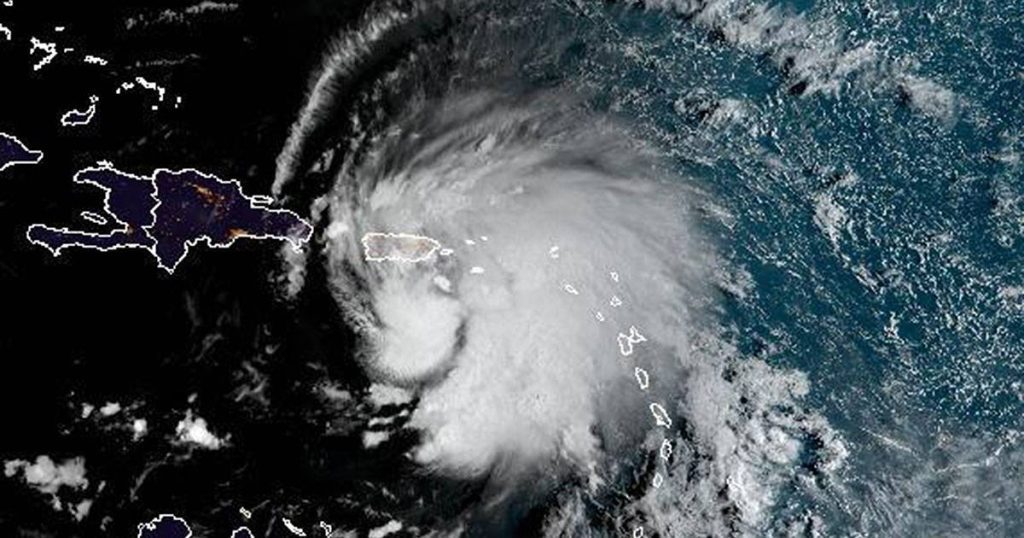
Hurricane Fiona intensified overnight and became a hurricane today. It moved just south of Puerto Rico resulting in up to 25 inches of torrential rain in some parts of the island.
As of 2 p.m., the National Hurricane Center said its center was located about 25 miles south of Ponce, Puerto Rico with maximum sustained winds of 85 mph moving from west to northwest at 8 mph.
Hurricane-force winds extend outward of up to 140 miles as winds return Sunday afternoon at weather stations in Puerto Rico that are reported to have gusted speeds of 69 miles per hour.

“On the forecast track, Fiona’s center will approach Puerto Rico this morning, and move near or above Puerto Rico this afternoon or evening.” said NHC hurricane expert Brad Reinhart. “Fiona will then move near the northern coast of the Dominican Republic tonight and Monday, near or east of the Turks and Caicos Islands on Tuesday.”
Hurricane warnings are in effect in Puerto Rico and parts of the Dominican Republic with hurricane watches in place in the US Virgin Islands. Tropical storm warnings are still in effect for the US and British Virgin Islands, and more of the Dominican Republic, and there is a tropical storm watch in effect for the Turks and Caicos Islands and the southeastern Bahamas.
The NHC reports that the system’s heavy rain continues to fall on both the US and British Virgin Islands, but is now moving over Puerto Rico and is expected to start affecting the Dominican Republic by the end of the day.
“These amounts of rain will lead to life-threatening flash floods and urban flooding across Puerto Rico and parts of eastern Dominican Republic, along with mudslides and landslides in higher terrain areas,” Reinhart said.
It is expected to drop 12 to 16 inches over the entire island with some areas as high as 25 inches.
“It’s time to take action and be concerned,” said Nino Correa, Puerto Rico’s emergency management commissioner.
The storm was expected to hit cities and towns along Puerto Rico’s southern coast that are still recovering from a series of strong earthquakes that hit the region as of late 2019, with many schools still closed and debris cleared. More than 100 people had sought shelter across the island by Saturday night, most of them in the southern port city of Guayanila.
With Fiona due just two days before the anniversary of Hurricane Maria, a deadly Category 4 storm that struck on September 20, 2017, anxiety levels rose across the island. People climbed up to the windows and stocked up on food and water.
“I think all of us Puerto Ricans who have lived through Maria suffer from post-traumatic stress, ‘What’s going to happen, how long is it going to last and what needs might we have?'” Danny Hernandez, who works in the capital of San Juan but planned to weather the storm with his parents and family in the western town of Mayaguez.
Many Puerto Ricans were also concerned about the blackout, with Luma, which operates power transmission and distribution, warning of “widespread outages.”
Hurricane Maria devastated Puerto Rico’s power grid and it remains vulnerable, with reconstruction only beginning recently. Outages occur on a daily basis, and fires have occurred at power plants in recent months.
Puerto Rico’s governor, Pedro Berluisi, said he’s ready to declare a state of emergency if necessary, and activated the National Guard as the sixth named storm of the Atlantic hurricane season approaches.
Updated trajectory for the system predicts travel away from Florida, with the center passing over western Puerto Rico as the system heads northwest and intensifies as it passes east from the Turks and Caicos Islands into the Atlantic and threatens Bermuda through the weekend as a strong Category 2 system with 110-mile winds per hour and winds of 130 mph.
Already, storms and a deluge from Fiona swept through the Caribbean island of Guadeloupe, where at least two people were reported to have been swept away and more than 20 people had to be rescued by rising waters on Saturday. One of them was confirmed dead by Sunday.
The storm left massive damage to roads in Guadeloupe, with a video posted on Twitter showing fast-moving floods swept through streets and two-feet flooded streets that swept away cars.
Expected rainfall was more than 8 inches in some parts of the island.
Government officials at the French Foreign Ministry said two people were missing due to rising waters overnight.
Elsewhere in the Atlantic, a tropical wave was detected Thursday halfway between the west coast of Africa and the Lesser Antilles. The weather system produces unregulated showers and thunderstorms, and is expected to develop slowly late this weekend and early next week when it turns north over the central subtropical Atlantic. NHC gives it 20% of the composition over the five days.

Despite the low chances, their appearance coincides with Colorado State University releasing its tropical forecast for the next two weeks, saying that the tropics could get busier with a 50% chance of above-average activity. CSU also gave a 40% chance of normal activity and a 10% chance of below-average activity.
Fiona could become the third hurricane of the season after hurricanes Daniela and Earl earlier this month.
What was expected to be an above-average tropical season was mostly quiet in July and August before gaining momentum on September 1.
The Atlantic hurricane season runs from June 1 through November. 30.
The Associated Press contributed to this report.

“Travel specialist. Typical social media scholar. Friend of animals everywhere. Freelance zombie ninja. Twitter buff.”





More Stories
Taiwan is preparing to face strong Typhoon Kung-ri
Israel orders residents of Baalbek, eastern Lebanon, to evacuate
Zelensky: North Korean forces are pushing the war with Russia “beyond the borders”